


Mark and Penny Dravers are celebrating a hat trick of ruby anniversaries. In the space of just a few weeks in late 1982 and early 1983, the couple, then in their 20s, got married, relocated to Guernsey, and sank whatever savings they had into a small and struggling shellfish business with a highly uncertain future run from Hougue Noirmont quarry on Guernsey’s north-east coast.
“We moved here a week after we got married,” said Mark. “We had our honeymoon at a Ministry of Agriculture, Fisheries and Food laboratory in North Wales, which I’ve never lived down, and then we packed up what we had and moved to Guernsey.”
“We were given a one-year housing licence,” said Penny. “We’d packed in our jobs, invested all our savings into equipment loaded into a shipping container to try to make a go of the business here, and we had the certainty of only one year. Very soon after we took over the business, having invested a lot into it, someone from the States came down and asked to do some measurements in the quarry because they were looking at the possibility of dumping rubbish in it. We couldn’t believe it.”
Mark and Penny’s risk paid off: landfill ended up a little further around the north coast and they were left to build Guernsey Sea Farms into a great family-run success story, operating one of only two mollusc hatcheries in the British Isles and exporting up to 10 tonnes a year, primarily of disease-free oyster seed, to Europe, Africa and North America, together with a sideline business supplying laboratories for eco toxicology tests.
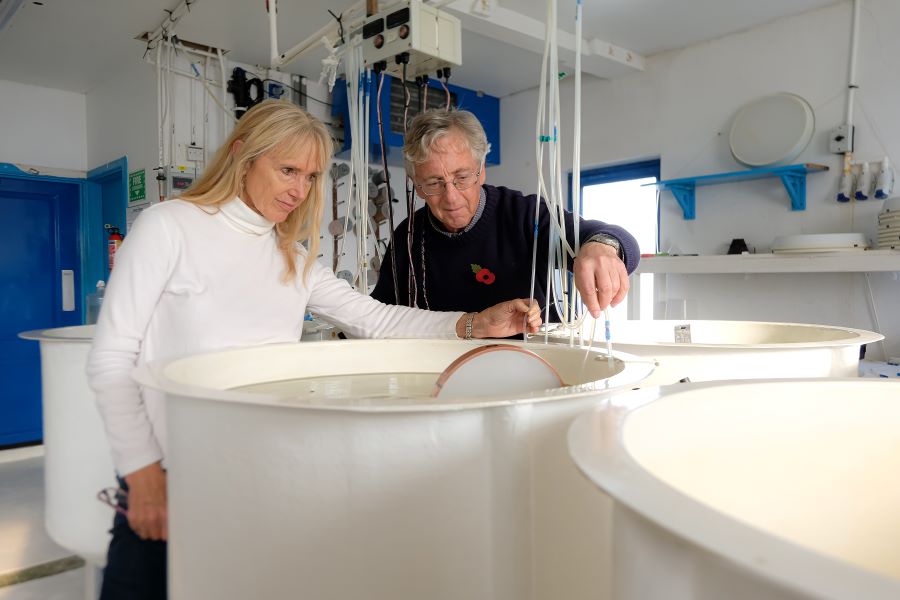
Pictured: Penny and Mark Dravers looked around the world for the best place to set up their hatchery before choosing Guernsey 40 years ago and they have grown their business into one of the island's great export success stories.
Guernsey Sea Farms is still growing and looking for new markets and Mark and Penny have lost none of their entrepreneurial spirit. They recently secured a deal to export 100 million clams to Italy. “That’s a new order,” said Mark. “Clams are something we did 20 years ago. Then the market wasn’t so good. Now, for various reasons, the market in Italy and Spain has re-emerged and it’s a very large market.” About one in 20 of the clams imported by Italy next year will come from Guernsey. “We sell them very small to another nursery who will grow them on in their local waters until they’re big enough to supply clam farmers, who will grow them more in the sand in the lagoons around Venice, before they are sold on to restaurants.”
A mollusc hatchery breeds, hatches and rears through the earliest life stages. By the time the shellfish reaches a plate, it has been developed to harvest size by at least one other grower. “Normally, our customers are oyster growers who take the seed oysters and put them in mesh bags and grow them in the sea to market size,” said Mark. It may take two or three years for an oyster which started life at the Hougue Noirmont quarry to reach a restaurant in Ireland or Canada or South Africa or Morocco, all countries supplied by Guernsey Sea Farms in recent years.
Penny shows me into her algae room, which is where the process starts. “The most important part of rearing oyster larvae is producing the food for them,” she said. “They feed on microscopic algae – single cell particles which you can see only under the microscope. Different algae grow better at various times of the year and oysters need a variety of algae – like a balanced diet. We carefully select what we need. I call them my babies. It’s not always easy – algae can be fussy at times. The water is sterilised to 120°C. We didn’t have that when we started: we were rearing oysters in little Woolworths’ buckets and I had a gas stove to boil water.”

Pictured: Guernsey Sea Farms exports several tonnes a year to Europe, Africa and North America.
Heat is important throughout the process, said Mark. “The seed comes from the adult oysters. We have to condition them until they develop eggs or sperm. It takes about four to six weeks of feeding them really well in heated water. They think summer is coming on, which is the normal time they spawn. We can spawn them at any time of the year by raising the temperature, feeding them and giving them a temperature shock. They will typically spawn and release their eggs on a rising temperature. In the wild, that would be because the tide was coming in over the hot sand and the eggs would get carried up into an estuary.
"Each female oyster can provide up to 50m eggs – typically, about 20m eggs. We only need about 10 oysters to give us over 200m eggs. In the course of a year, we’ll do half a dozen spawnings.” The seed are only millimetres in size at the point they leave Guernsey Sea Farms, chilled and packed dry in polystyrene boxes, but they are recognisable as miniature oysters because they develop their shells straight away.
“We grow some oysters of our own in the Miellette Bay. On a spring tide, you can see our tables. But we don’t grow any to sell to the public. We put a few thousand down there. Out of that, we select a few hundred that are the best shape and size for breeding.
“Our largest market by number of oyster seeds is Canada. We ship to Vancouver Island in 36 hours by air freight. In many of our markets around the world, an obvious question is why they don’t produce their own seed. The hatchery process is quite difficult and specialist with any number of technical challenges. Over the years, we have gradually refined the process.
"And in recent years, our unique selling point has been our disease-free status. France has a very large industry but has all the diseases known to man. Jersey has a viral disease which can kill oysters when they’re small. We have very strong biosecurity measures and we’re fortunate not to have the disease here.”
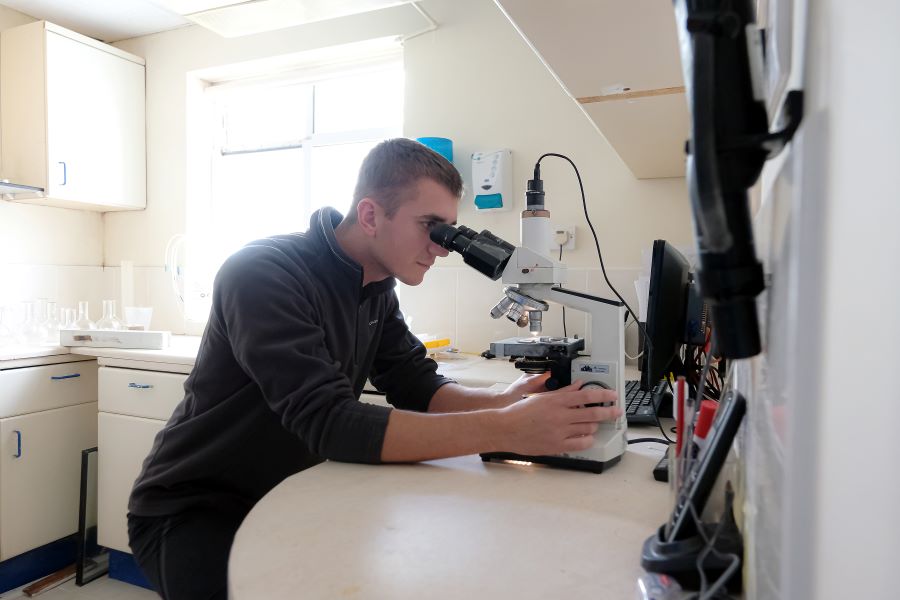
Pictured: Callum Hockey, Trainee Hatchery Manager, joined Guernsey Sea Farms in 2021 after studying biology at Exeter University.
As well as exporting seed around the world, Guernsey Sea Farms supplies the local oyster farmers who run part of their business from Herm. “The Guernsey market is an interesting part of the story,” said Mark. “At the same time as we started in the 1980s, Herm Island oysters was started from nothing by a Frenchman, Hugo Vajk, and his wife, Judith. They were there for about eight years, I think. We stayed in very close contact with them when they moved and became the largest oyster farm in Scotland, Caledonian Oysters.”
Sadly, in 2018, Hugo drowned in freezing water while trying to rescue equipment at his oyster farm. The Herm business is now run by Justin de Carteret and Charlotte Dickson. “They take our bigger seed,” said Penny. “All their seed comes from us. They are a very important customer. We take their brood stock for breeding. We work closely together and support each other. We love hearing about local sales of oysters.”
Mark and Penny’s sideline business in eco toxicology has grown steadily over 20 years. “The oyster larvae are incredibly sensitive to pollution when they are developing from the egg after fertilisation,” said Mark. “They provide the most sensitive biological test you can do for the quality of water and toxicity of chemicals. You take a new chemical or an existing chemical for licensing purposes and you test it against invertebrate larvae in the sea.
"We supply the oysters, already conditioned male and female sex, and they go off to laboratories all over Europe. We also supply a species of copepod, which are the next stage of the food chain after algae. They are also sensitive to pollution and so we supply them to laboratories, all from our stock grown in Guernsey.”

Pictured: Scott Le Prevost, Nursery Manager, has worked for Guernsey Sea Farms for more than 20 years.
The business employs four staff, slightly fewer than before the pandemic, during which new ways were found to boost productivity. Scott, who has worked there for more than 20 years, runs the nursery. Callum joined as trainee hatchery manager in 2021 after studying biology at Exeter University.
Mark and Penny’s story started at Southampton University, where they met as undergraduates. He read mechanical engineering; she read environmental science. “Mark didn’t really like going to any of the lectures,” said Penny. “He was either in the library or flying with the RAF squadron. He picked up something in the library one day and read about a research programme on oysters which had been started by the Ministry of Agriculture, Fisheries and Food. That’s where it all started. He went to work in the Outer Hebrides farming salmon before farming salmon really took off.”
Mark explained how they ended up in Guernsey. “Knowing that we were interested in oysters, I kept pestering the only commercial oyster hatchery, which was in Whitstable in Kent, and they ended up offering me a job,” he said. “I worked there for three years. We were young and naïve and we had the idea of setting up our own business. We looked around the world, including Canada and America, where we spent a month, for places we could start an oyster farm, particularly a hatchery or nursery.
"We came to Guernsey as part of that tour and realised there was a business here which had been started as an ormer farm in the early 1970s after the quarry was flooded. They couldn’t quite work out how to grow ormers – no-one had done that then. So, basically, this place existed as a potential oyster farm, and we decided to give it a go and set up a hatchery here.”
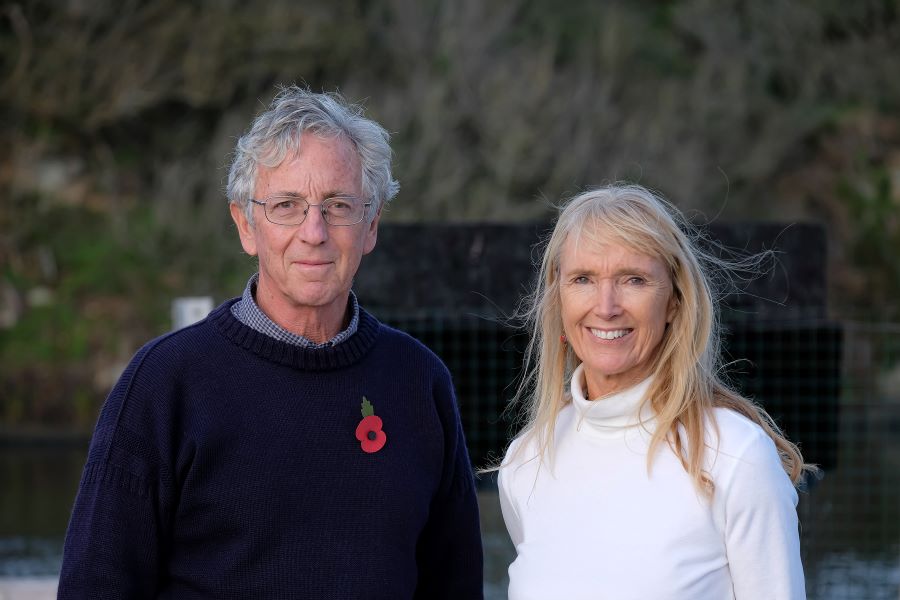
Pictured: Mark and Penny met when they were students at Southampton University.
Not long after moving to Guernsey, Mark and Penny bought the home they still live in, just inland from Bordeaux Harbour and only half a mile from their business – so they have worked together daily, very close to their home, almost all their adult lives.
“It’s quite unusual, I suppose,” said Penny. “There is not too much conflict between us. Mark is the engineer, the designer, the boffin who is brilliant on computers and designed most of the equipment here. Whereas I have a more touchy-feel role with the stock. If my oysters look hungry, I get very upset. I have a maternal instinct about them,” she joked.
The business has experienced ups and downs, but “the downs have never made us contemplate getting out,” said Mark. “Anyway, after a certain time, we realised that, since this was the only job either of us had ever done, we didn’t have much choice but to carry on making it work. It’s become a lifestyle.”
But after 40 years doing this, and now in their 60s, the couple are thinking about how to secure the future of the business without them. Penny perhaps a little more enthusiastically than Mark, who she describes as “a workaholic”. “We’ve absolutely loved what we’ve done, but we’d like to take a step back,” she said.
“It comes as a bit of a shock when you get a letter from Social Security saying you can now claim your pension, and you think to yourself that you’re not going to do this for ever,” said Mark. “We think it would be a long handover. We’re not looking for an investor – we’re looking for someone to be hands-on who would effectively buy into the business. We’ve made a good living and had an enjoyable lifestyle doing something we find interesting, and we’d like someone else to be able to do that while keeping the concept of the business going.”
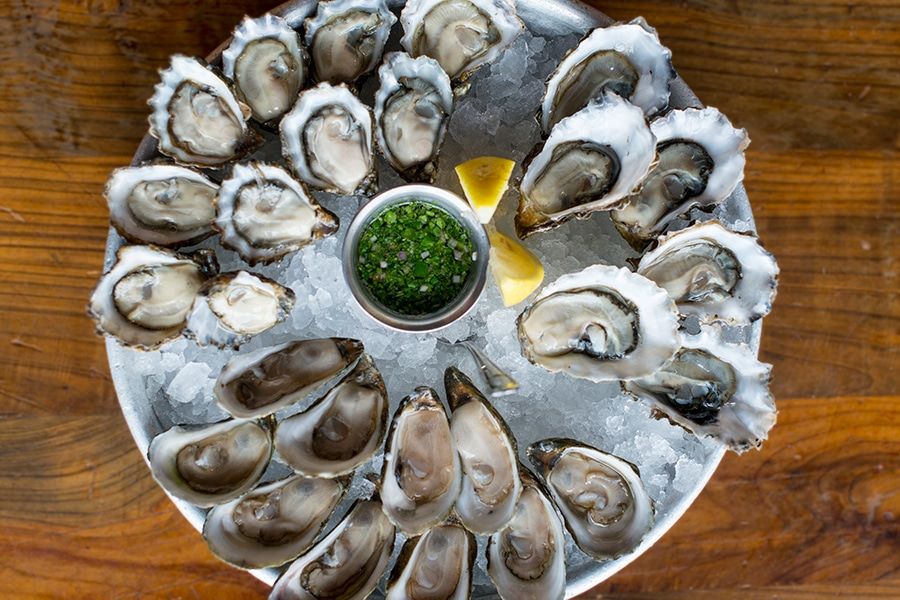
Pictured: Oysters eaten in local restaurants are likely to have started life with Mark and Penny at Guernsey Sea Farms, although exports outside the Bailiwick make up the vast majority of their sales.
They recall their two children having a lot of fun around the quarry when they were younger. “They would come down and play with the water and squirt things,” said Penny. But they have their own lives in England – one in the finance industry and one running a social enterprise – and so there are no plans to keep the business in the family.
“I hold on to the idea that we can find someone in Guernsey – perhaps someone who is looking for a change at the moment or who has studied biology and wants to work in a related business,” said Mark. “We’ve made a success of doing it this way. Equally, a new owner might want to take it in a different direction, perhaps doing more on the environmental side of the business.
"It’s even possible that some of the testing done by the laboratories we supply could be done over here. A marine field station with links to the College of Further Education and a university is another possibility.” Penny thinks seaweed, in which her father was an expert, provides another potential opportunity. “We are now actively looking for someone who would be interested in taking it on,” said Mark.
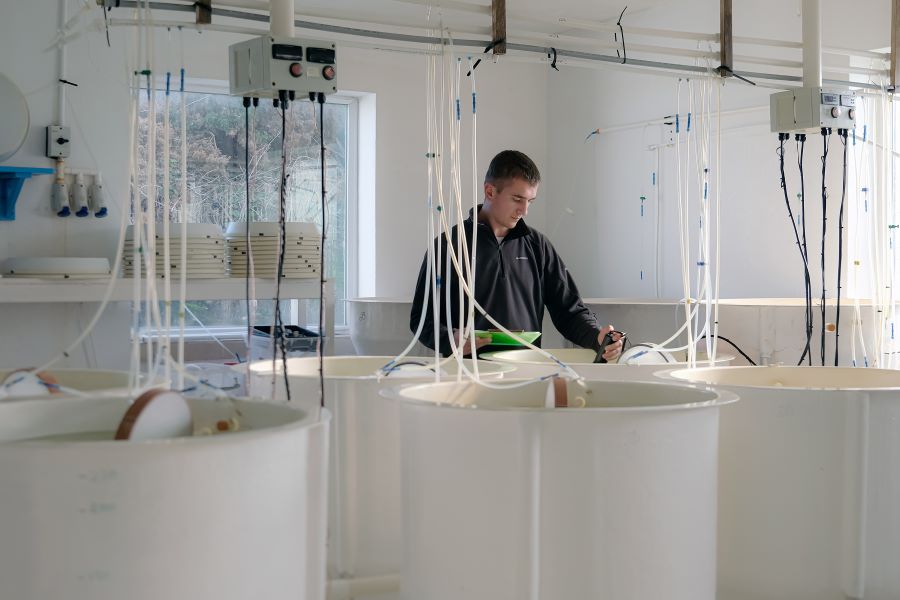
Pictured: These tanks contain millions of oyster eggs. A female oyster can provide up to 50million eggs and typically provides around 20m.
“This is a very unique site. The quarry is a natural marine ecosystem. We don’t own the quarry. It’s a unique asset to Guernsey and we’re making good use of that asset. We would really like to see it continue and for the quarry to be protected. My ambition is to see the ownership of the quarry in some sort of not-for-profit structure which protects it for future generations.
"The reason we don’t own it and have always had a relatively short lease is because there has always been the prospect of it becoming something else, like a rubbish tip. I think the risk of using it for noxious waste has gone, but not for inert waste perhaps. Like a lot of the quarries, you think of them as holes in the ground, but they are havens for wildlife.
“There’s a strong future for the blue economy. We’re growing something natural. We’re not adding any chemicals or antibiotics. We’re not even having to feed the animals, like agriculture farming. It’s a natural process. We’re fixing carbon – that’s a fashionable thing – into the shells of the oysters.”
This has been a life’s work – or two lives’ work. Having heard Penny speak of the stock as her “babies” and Mark call the business more “a lifestyle”, it is clear that moving on from it will not be easy. “After building the business for 40 years, we would love to see it continue. In an ideal world, we’d still be pottering around, but with younger people taking the business forward,” said Mark.
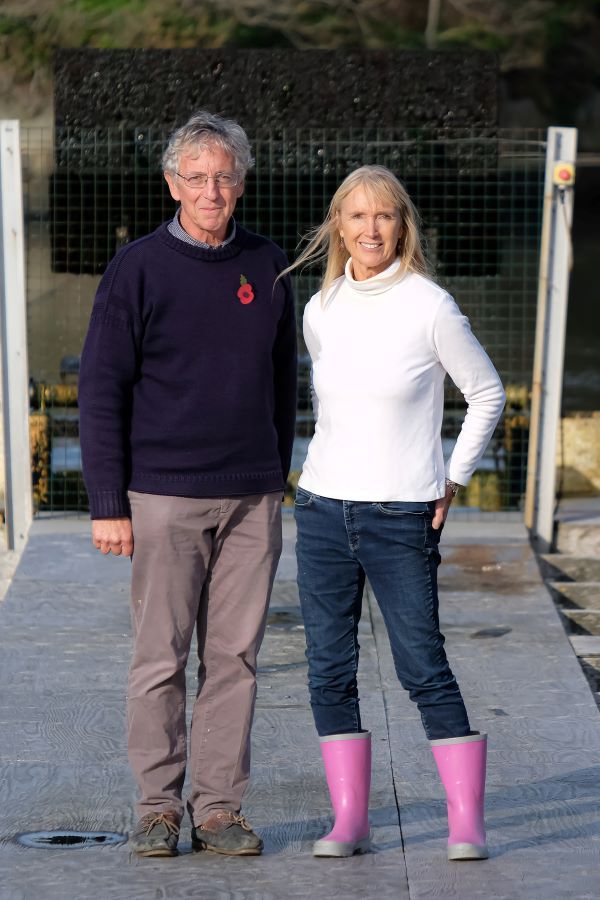
Pictured: Mark and Penny hope they will be able to pass on their business to people who will write the next successful chapter of a story started in a small corner of the Vale four decades ago.
Pictures by Paul Chambers
READ MORE...
CONNECT interview: Building for the Future of Primary Care
CONNECT interview: Meet the custodian of our island's heritage
CONNECT interview: The man behind the scenes at the KGV
FOCUS: A Life in Light and Darkness
FOCUS: Work-life balance is next challenge for PR expert
Comments
Comments on this story express the views of the commentator only, not Bailiwick Publishing. We are unable to guarantee the accuracy of any of those comments.